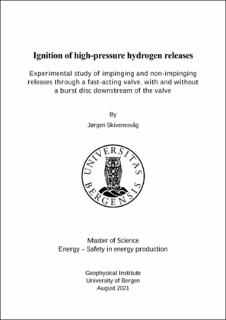| dc.description.abstract | A wide consensus of climate research indicates that anthropogenic greenhouse gas emissions affect the climate and causes the global mean temperature to rise compared to preindustrial levels. International treaties such as the Paris Agreement intend to mitigate these expected changes by commitments to greenhouse gas reductions from the voluntary attending nations. The reductions must be effectuated as continuous reductions during the coming decades. Significant changes to the global energy systems are necessary to facilitate for emission reductions. As much as possible of the current fossil-based energy consumption must be substituted with carbon free alternatives. Hydrogen is a viable substitution for carbon-based energy carriers in many applications as it does not emit carbon during combustion and has a very high mass-energy density. However, there are some additional hazards associated with utilisation of hydrogen. It very reactive and has very low minimum ignition energy (MIE). As a consequence of this, it has a high propensity to give spontaneous ignition during unintended releases. Although hydrogen has been in use for industrial applications for more than a century, the mechanisms that lead to spontaneous ignition are not fully understood. This thesis aimed to investigate the most important ignition sources that could contribute to spontaneous ignitions, and in particular the mechanism known as diffusion ignition. Based on the findings from previous work, an experimental setup was constructed, and relevant experiments conducted. The experiments investigated the propensity for spontaneous ignition to occur when hydrogen was released through a nozzle. Some experiments investigated conditions where the released hydrogen was impinged on objects of different size and shape located at various distances from the nozzle exit. Other experiments investigated non impinging jets. Two different setups were used. One setup used a fast-acting valve to control the hydrogen release and allowed investigation of release scenarios that developed in a time scale of 30-60 ms. Another setup used rupture discs. These discs enabled investigation of releases that developed in a timescale of a few microseconds. Tests with pressures up to 165 bar were conducted with the release valve setup. Neither impinging, nor non-impinging releases were able to cause ignition. Tests with the rupture disc setup gave ignitions in impinging conditions, but never in non-impinging conditions. The impinging object also had to be close enough if ignition should occur. The ignition source was not identified, and both spontaneous ignition and ignition caused by impact of debris from the rupture disc on the obstruction object was possible. Diffusion ignition appeared to be the most probable ignition of these two. The preliminary conclusions are that ignition repeatably occurs when hydrogen at sufficiently high pressure is released in a rapidly developed pattern and impinges on an object with satisfactory proximity. Further investigations are necessary to quantify the critical conditions. | |
